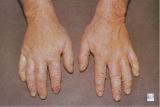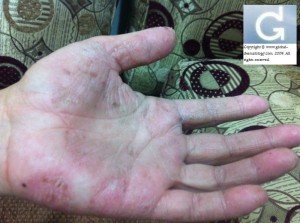Skin diseases related to housework
Dr Christophe HSU – dermatologist. Geneva, Switzerland
Common skin disorders that may arise from housework are:
Irritant contact dermatitis
- This is the commonest skin disorder that can arise from housework.
- It commonly affects the hands.
- The condition usually begins with mild dryness, redness, peeling and scaliness on the hands. Later cracks and crusts develop.
- Causes of irritant contact dermatitis due to housework commonly include:
- detergents
- cleansing agents
- foodstuff
- disinfectants
- water
- bleaches.
- Individuals with sensitive skin and pre-existing skin diseases e.g. atopic eczema are more prone to develop irritant contact dermatitis.
- Affected individuals should be encouraged to wear cotton gloves inside loose-fitting rubber gloves if wet work cannot be avoided. It is not advisable to wear rubber gloves for more than 30 minutes at a stretch, as perspiration may cause discomfort and maceration. If the patient is allergic to rubber gloves, vinyl gloves may be used as an alternative.
- Treatment includes use of topical steroid creams, moisturizers and oral antihistamines.
Allergic contact dermatitis
- This occurs less frequently than irritant contact dermatitis.
- It is often difficult to differentiate between an allergic from an irritant contact dermatitis by the appearance of the rash alone.
- Substances known to cause skin allergy include:
- rubber gloves
- food stuff (onions, garlic, fruits)
- spices
- flavouring agents
- certain hand creams
- fragrances
- nickel
- chromate (in bleaches)
- flowers
- polishes
- disinfectants.
- Skin allergies can be confirmed by a skin patch test.
- Once the patient is found to be allergic to a particular substance, he/she should make special efforts to avoid direct skin contact with the substance, in order to avoid worsening or relapse of the dermatitis.

- Contact dermatitis of the hands (allergic or irritant)
Contact urticaria
- This is an immediate but transient wheal response (localised swelling with redness) at the site of direct contact with the substance causing an allergic reaction.
- It usually resolves within a few hours, leaving normal skin.
- Contact urticaria can be confirmed by doing a skin prick test.
- Causes of contact urticaria include:
- foodstuff
- fragrances
- flavouring agents
- animal and plant products
- preservatives
- disinfectants
- rubber latex.
- Avoidance of the causative agent is important to avoid recurrance of the rash.
Fungal infections
a. Candida intertrigo
- refers to itchy red rash with white flakes, that is commonly seen at the fingerwebs.
- It is caused by yeast -infection.
- Moisture promotes candida infection.
b. Fungal nail infections
- may affect the fingers and toenails.
- The infection originates from the free margin and sides of the nails and eventually involves the nail plate, causing it to become brittle, thickened or completely destroyed.
- Skin fungal infections can be treated with antifungal creams and/ or tablets. Fungal nail infections may require prolonged treatment for up to one year. The affected nails may take up to a few months after the treatment has been stopped, to return to near normal appearance.
Paronychia
- This refers to inflammation with/without infection of the nail folds.
- It is commonly caused by constant wet work.
- Secondary infection by bacteria or fungus will cause painful swelling of the nail fold.
- The nail plate may become deformed with chronic infection of the nail fold.
- Patients with paronychia should avoid prolonged wet work or wear impervious gloves during wet work.
Viral Warts
- Viral warts commonly infect the hands, fingers, nail folds and nail beds.
- It may be further exacerbated by the mild repetitive trauma experienced during housework.
- Warts on the fingers and hands can be destroyed with liquid nitrogen or laser surgery.
- Wart infection around the nails, however, is very difficult to eradicate. The best treatment so far is laser surgery.
Contributors:
Dr Christophe HSU – dermatologist. Geneva, Switzerland
National Skin Centre. Singapore
Category : contact dermatitis - Modifie le 11.29.2009Category : dermite de contact - Modifie le 11.29.2009Category : Eczéma - Modifie le 11.29.2009Category : infection - Modifie le 11.29.2009Category : infections - Modifie le 11.29.2009Category : paronychia - Modifie le 11.29.2009Category : paronychie - Modifie le 11.29.2009Category : urticaire - Modifie le 11.29.2009Category : urticaria - Modifie le 11.29.2009Category : verrues - Modifie le 11.29.2009Category : viral wart - Modifie le 11.29.2009Category : warts - Modifie le 11.29.2009





